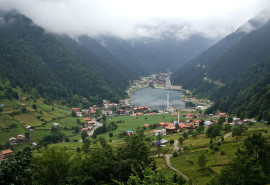Uzunyuva Mausoleum (Hecatomnus' Tomb)
ancient-cityUzunyuva Mausoleum and Museum Complex is situated in the Milas district of Mugla Province in Turkey. The Mausoleum belonged to Hecatomnus, the father of Mausolos and the local ruler of the Ancient City of Mylasa. The grave was founded in 2010 on the eastern slope of Hisarbasi Hill and is considered the most significant discovery in Milas for the last 100 years. It is the early version and inspiration of the Mausoleum at Halicarnassus, which is considered one of the seven wonders of the world. The Mausoleum of Hecatomnus' has the same architectural features as the Mausoleum at Halicarnassus, and when we consider its size, nature, and surrounding descriptions, it is one of its kind. In 2014, a 121-line poem was found in the inscriptions around the tomb. The poem was written to the ruler and is thought to be the longest in classical antiquity. It was inscribed on the Unesco World Heritage List in 2012.
Who was Hecatomnus of Mylasa or Hekatomnos?
Hecatomnus of Mylasa, also known as Hekatomnos, served as the governor (satrap) of Caria during the early 4th century under the reign of the Persian Achaemenid king Artaxerxes II. He was a prominent figure in the local Carian dynasty and notably, the first non-Persian official to attain such a position. Historians note his demise in 377 after being tasked with commanding the naval forces intended for participation in the war against Evagoras I of Cyprus. Hecatomnus of Mylasa is also the father of Mausolus, who served as the satrap of the Achaemenid Empire. Mausolus is best known for his monumental tomb, which became one of the Seven Wonders of the Ancient World, the Mausoleum at Halicarnassus.
Why is the Uzunyuva Mausoleum, also known as Hecatomnus' Tomb, significant?
The Uzunyuva Mausoleum, also known as Hecatomnus' Tomb, is an early version of the Mausoleum of Halicarnassus, one of the seven wonders of the ancient world. Built by Mausolos, the satrap of Caria and son of Hecatomnus, the Uzunyuva Mausoleum holds historical significance.
Uzunyuva Mausoleum, a site bearing traces of the Carian civilization's founding, which established cities in the southwest of Anatolia and progressed from governance to kingship, holds significant cultural and artistic value. Particularly noteworthy are the sculptural reliefs adorning the sarcophagus and the wall paintings within the burial chamber, some retaining their original colors, showcasing the artistic standards of the period. Hecatomnus' Tomb is considered a unique Anatolian example due to its size, quality, and personality. It features a hunting scene of Hekatomnus on the front and one of Mausolus on the back.
In 2014, a 121-line poem was discovered in the inscriptions surrounding Hecatomnus' Tomb. This poem, considered the longest of classical antiquity, was dedicated to the ruler. It portrays Hekatomnus as a mortal rather than divine, focusing on the battles he waged. The most significant detail we learn from it is Hekatomnus' friendship with Pytheas, the architect of the Mausoleum of Halicarnassus. Uzunyuva Mausoleum, also known as Hecatomnus' Tomb is the largest burial site of ancient times.


-thumb.jpg)

